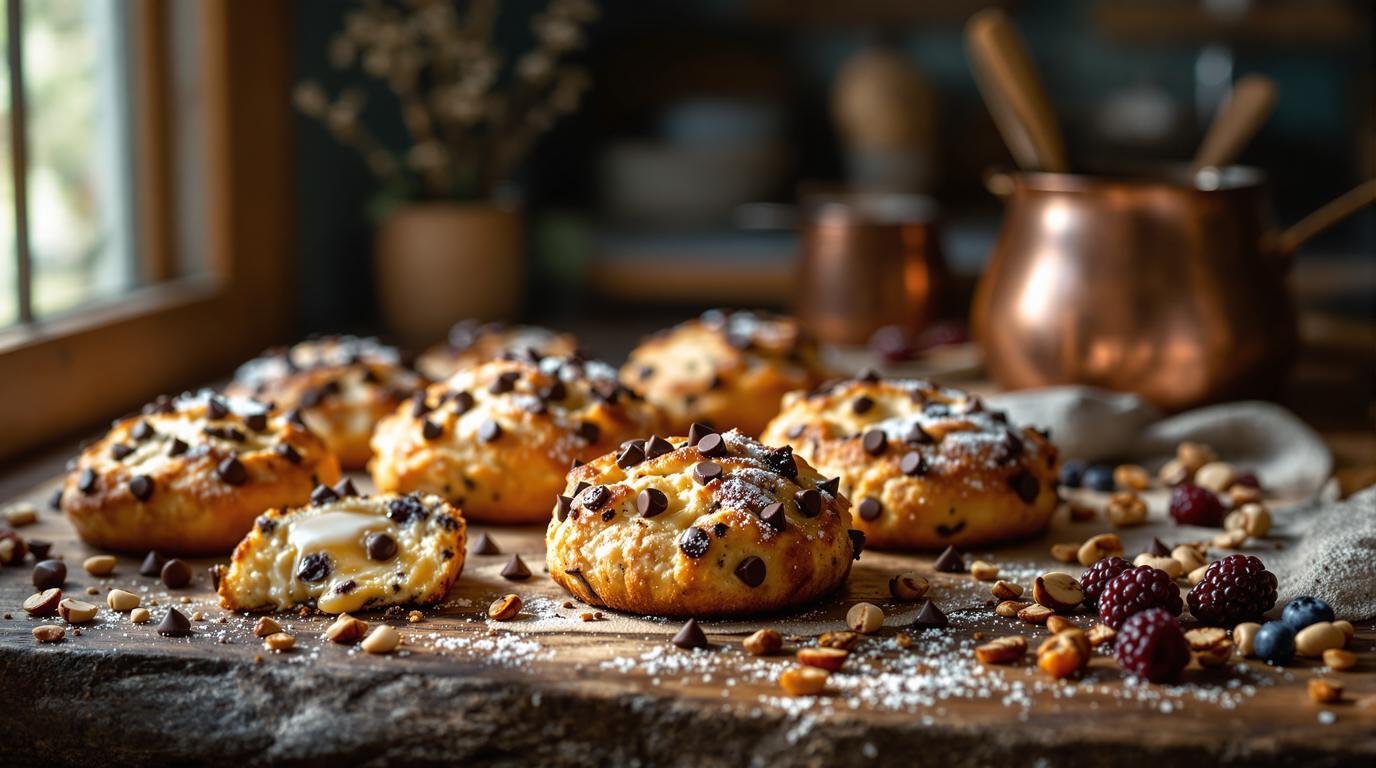Picture this: a quiet Sunday afternoon in my grandmother’s kitchen in Provence. The windows are cracked open, and the warm breeze carries the scent of nearby lavender fields. On the wooden countertop sits a tray of golden-brown friands, their tops crackled to perfection and studded with melting chocolate. The nutty aroma of brown butter fills the air. This memory is what inspired my take on these delicate French-Australian treats that balance rustic simplicity with refined technique.
The Story Behind Brown Butter & Chocolate Chip Friands 📖
Friands (meaning “little friends” in French) have a fascinating culinary journey. Born in France, they found unexpected popularity in Australia, where they’ve become a café staple. These small oval cakes traditionally use almond meal, but my version introduces toasted hazelnuts paired with nutty brown butter—a combination that elevates these treats from simple to sublime. The first time I served these at my restaurant, a French grandmother told me they reminded her of home, despite my unorthodox additions. That’s the beauty of respecting tradition while embracing innovation.
Essential Ingredients 🧾
The magic of friands lies in their simple ingredient list, where quality matters tremendously:
- 180g (¾ cup) unsalted butter
- 125g (1 cup) hazelnuts, toasted
- 50g (⅓ cup) plain flour
- 180g (1½ cups) icing sugar, sifted
- 5 large egg whites, room temperature
- 80g (½ cup) dark chocolate chips (70% cocoa recommended)
Chef’s Note: For a traditional friand experience, substitute 25g of the plain flour with almond flour and reduce the hazelnuts to 100g. This provides the classic almond notes while maintaining the hazelnut accent.
Step-by-Step Instructions 📝
1. Preheat your oven to 200°C (400°F) and lightly butter your friand molds or a 12-cup muffin tin.
2. Make the brown butter by melting the butter in a light-colored saucepan over medium heat. Watch carefully as the butter foams, then begins to brown and develop a nutty aroma—about 5-7 minutes. Once it smells like hazelnuts and has amber specks, immediately transfer to a heatproof bowl to stop the cooking. This technique, called “beurre noisette,” transforms ordinary butter into liquid gold.
3. Toast hazelnuts in a dry skillet over medium heat until fragrant (about 5 minutes), shaking occasionally. Reserve a small handful for topping, then pulse the rest in a food processor until finely ground but not oily.
4. In a large bowl, whisk together the ground hazelnuts, flour, and icing sugar.
5. In a separate bowl, lightly whisk the egg whites just until frothy—not stiff peaks. This provides lift without creating a meringue texture.
6. Make a well in the dry ingredients, pour in the egg whites and brown butter, and fold together with a rubber spatula using gentle, sweeping motions until just combined.
7. Fold in the chocolate chips, being careful not to overmix. The batter should be glossy and flowing.
8. Divide the batter among the prepared molds, filling each about ¾ full, then sprinkle with reserved chopped hazelnuts.
9. Bake for 15-20 minutes until golden on top but still slightly soft in the center. A toothpick should come out with a few moist crumbs.
Chef’s Secret Techniques 🤫
The distinction between a good friand and an exceptional one comes down to technique. Never rush the brown butter process—those precious extra minutes develop complex flavor compounds that make these cakes unforgettable. When incorporating egg whites, use a light hand; overmixing will deflate the batter and produce dense friands. And always let them cool in the tin for 10 minutes before attempting to remove them—the structure needs time to set.
Serving & Presentation Tips 🍽️
Friands shine in their rustic elegance. Dust with a light veil of powdered sugar just before serving. For an elevated experience, pair with fresh berries and a dollop of lightly whipped cream or crème fraîche. These delicate cakes complement both dessert wines like Sauternes and artisanal coffees beautifully. The contrast between the crisp exterior and moist interior is particularly delightful when served slightly warm.
My students often ask why friands aren’t more common in America. I believe these little treasures deserve wider recognition—they occupy that perfect middle ground between everyday treat and special occasion indulgence. Like Japanese mochi or Italian gnocchi, they represent the beautiful simplicity found in global cuisines.
For an interesting fusion twist, consider the approach of Korean-inspired pancakes by adding a pinch of five-spice powder to your friand batter. Or draw inspiration from Greek spoon sweets by serving with poached fruits.
These friands connect us to both French precision and rustic comfort food traditions similar to ancient Roman flatbreads. When you bite into one still warm from the oven, you’ll understand why this humble little cake has traveled across continents and generations. Remember, in baking as in life, it’s often the simplest pleasures that bring the most joy.
